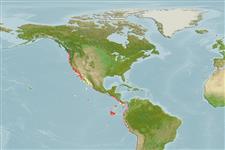>
Gadiformes (Cods) >
Macrouridae (Grenadiers or rattails)
Etymology: Nezumia: A Japanese word that means "mouse" ; stelgidolepis: stelgidolepis meaning scraper scale, referring to the rasplike scales that cover the body (Ref. 4525).
More on author: Gilbert.
Environment: milieu / climate zone / depth range / distribution range
Ecología
marino batidemersal; no migratorio; rango de profundidad 277 - 909 m (Ref. 1371). Deep-water; 49°N - 16°S, 130°W - 76°W (Ref. 1371)
Eastern Pacific: off Vancouver Island, Canada to southern Peru.
Tamaño / Peso / Age
Maturity: Lm ? range ? - ? cm
Max length : 84.0 cm TL (female)
Short description
Morfología | Morfometría
Espinas dorsales (total): 2; Espinas anales 0. Snout short, narrow, bluntly pointed; terminal snout scute developed but not conspicuously; suborbital ridge low; underside of snout, most of the suborbital region, and anterior half of mandible without scales; cephalic pores of the lateralis system prominent. Pyloric caeca 24 to 58. Body scales densely covered with conical to narrowly lanceolate spinules in short, slightly convergent rows. Overall color is swarthy, blackish ventrally, with bluish tinge on abdominal region; oral and branchial cavities generally pale with some blackish areas; fins dusky to blackish, first dorsal fin slightly paler basally.
Food items are generally forcibly regurgitated by the fish's expunging gas bladder as it is hauled from the depths, but fish remains have been caught inside the mouth of a few individuals. Considered opportunistic feeders and will eat whatever animal food they encounter in the natural habitat as long as it is of appropriate size (Ref. 4525).
Life cycle and mating behavior
Madurez | Reproducción | Puesta | Huevos | Fecundidad | Larva
Cohen, D.M., T. Inada, T. Iwamoto and N. Scialabba, 1990. FAO species catalogue. Vol. 10. Gadiform fishes of the world (Order Gadiformes). An annotated and illustrated catalogue of cods, hakes, grenadiers and other gadiform fishes known to date. FAO Fish. Synop. 125(10). Rome: FAO. 442 p. (Ref. 1371)
IUCN Red List Status (Ref. 130435)
Threat to humans
Harmless
Human uses
Pesquerías: escaso valor comercial
Más información
Nombres comunesSinónimosMetabolismoDespredadoresEcotoxicologíaReproducciónMadurezPuestaAgregación para la puestaFecundidadHuevosEgg development
ReferenciasAcuiculturaPerfil de acuiculturaRazasGenéticaElectrophoresesheritabilidadEnfermedadesProcesamientoNutrientsMass conversion
Herramientas
Special reports
Download XML
Fuentes de Internet
Estimates based on models
Preferred temperature (Ref.
123201): 5 - 9.8, mean 8.4 °C (based on 47 cells).
Phylogenetic diversity index (Ref.
82804): PD
50 = 0.5000 [Uniqueness, from 0.5 = low to 2.0 = high].
Bayesian length-weight: a=0.00214 (0.00124 - 0.00369), b=3.18 (3.03 - 3.33), in cm total length, based on LWR estimates for this species & (Sub)family-body (Ref.
93245).
Nivel trófico (Ref.
69278): 4.4 ±0.80 se; based on food items.
Generation time: 5.5 ( na - na) years. Estimated as median ln(3)/K based on 1
growth studies.
Resiliencia (Ref.
120179): Medio, población duplicada en un tiempo mínimo de 1.4-4.4 años (K=0.20).
Fishing Vulnerability (Ref.
59153): Moderate to high vulnerability (51 of 100).
